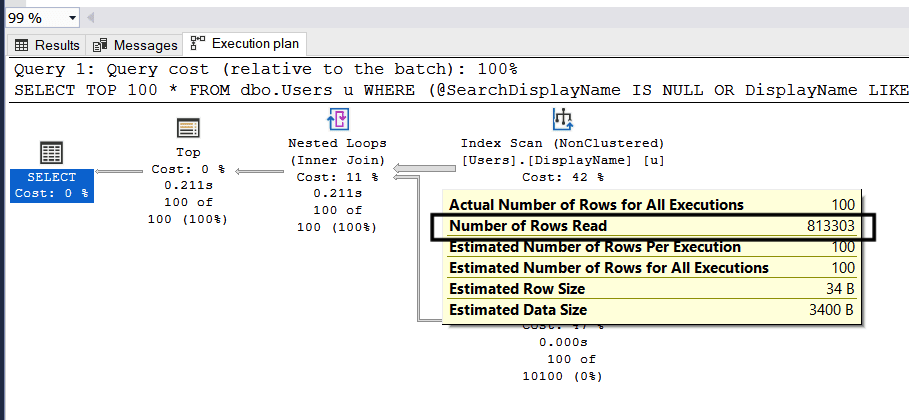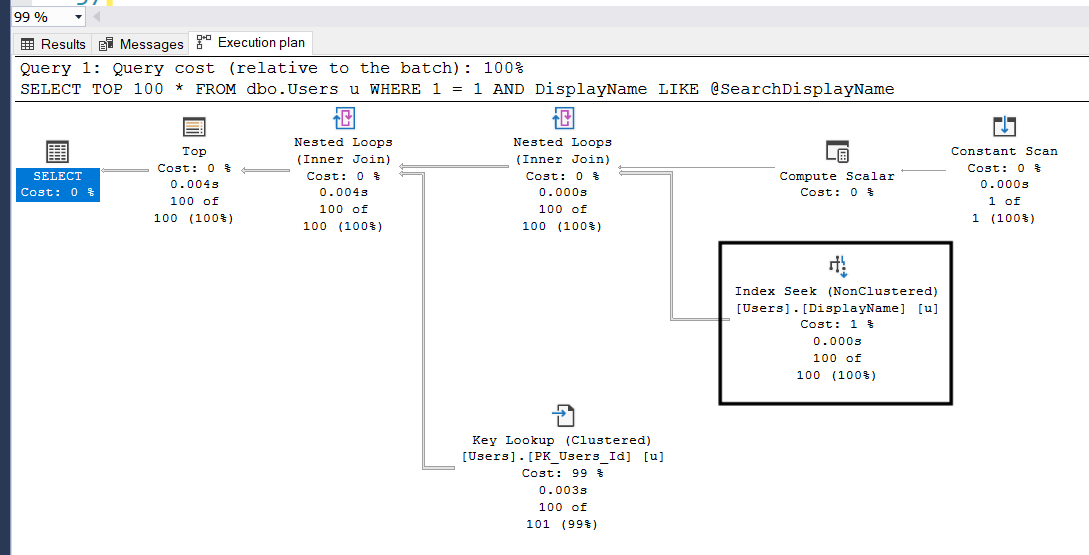How not to write Dynamic SQL
08 Mar 2021 #tutorial #sqlLast time, I showed you three tips to debug your Dynamic SQL. Let’s take a step back. Let’s see what is a dynamic SQL query and how to use one to rewrite a stored procedure with optional parameters.
Dynamic SQL is a string with a query to execute. In a stored procedure with optional parameters, Dynamic SQL is used to build a string containing a query with only the comparisons and clauses for the parameters passed with a non-default value.
Without Dynamic SQL
Let’s go back to the stored procedure dbo.usp_SearchUsers from our previous post on debugging Dynamic SQL queries. This stored procedure finds StackOverflow users by display name or location or both.
Without Dynamic SQL, we end up with funny comparisons in the WHERE clause. First, we check if the optional parameters have value. To then, with an OR, add the right comparisons. Everything in a single statement.
CREATE OR ALTER PROC dbo.usp_SearchUsers
@SearchDisplayName NVARCHAR(100) = NULL,
@SearchLocation NVARCHAR(100) = NULL
AS
BEGIN
SELECT TOP 100 *
FROM dbo.Users u
WHERE (@SearchDisplayName IS NULL OR DisplayName LIKE @SearchDisplayName)
AND (@SearchLocation IS NULL OR Location LIKE @SearchLocation);
END
GO
Let’s run our stored procedure searching only by DisplayName and see its execution plan.

Notice SQL Server had to scan the DisplayName index and see the number of rows read.
Sometimes, we use the ISNULL() or COALESCE() functions instead of IS NULL. But, those are variations on the same theme.
The more optional parameters our stored procedure has, the worse our query gets. SQL Server will scan entire tables or indexes to satify our query.

With Dynamic SQL, the wrong way
Probably, we hear about Dynamic SQL somewhere on the Internet and we decide to use it.
Then, we write the next version of our stored procedure. Something like the one below.
CREATE OR ALTER PROC dbo.usp_SearchUsersWithWrongDynamicSQL
@SearchDisplayName NVARCHAR(100) = NULL,
@SearchLocation NVARCHAR(100) = NULL
AS
BEGIN
DECLARE @StringToExecute NVARCHAR(4000);
SET @StringToExecute = N'SELECT TOP 100 *
FROM dbo.Users u
WHERE (@SearchDisplayName IS NULL OR DisplayName LIKE @SearchDisplayName)
AND (@SearchLocation IS NULL OR Location LIKE @SearchLocation);';
EXEC sp_executesql @StringToExecute,
N'@SearchDisplayName NVARCHAR(100), @SearchLocation NVARCHAR(100)',
@SearchDisplayName, @SearchLocation;
END
GO
We moved the exact same query to a string and asked SQL Server to execute that string. That won’t make any difference between the execution plans of both versions. We only put makeup on the problem. Arggg!
With Dynamic SQL, the right way
With Dynamic SQL, we want to create smaller queries for the different set of parameters passed to our stored procedure.
We need to add only the comparisons and clauses for the parameters passed with non-default values.
Let’s rewrite the stored procedure to include the conditions to the WHERE based on the parameters passed.
CREATE OR ALTER PROC dbo.usp_SearchUsers_DynamicSQL
@SearchDisplayName NVARCHAR(100) = NULL,
@SearchLocation NVARCHAR(100) = NULL
AS
BEGIN
DECLARE @StringToExecute NVARCHAR(4000);
SET @StringToExecute = N'SELECT TOP 100 *
FROM dbo.Users u
WHERE 1 = 1';
IF @SearchDisplayName IS NOT NULL
SET @StringToExecute = @StringToExecute + N' AND DisplayName LIKE @SearchDisplayName ';
IF @SearchLocation IS NOT NULL
SET @StringToExecute = @StringToExecute + N' AND Location LIKE @SearchLocation ';
EXEC sp_executesql @StringToExecute,
N'@SearchDisplayName NVARCHAR(100), @SearchLocation NVARCHAR(100)',
@SearchDisplayName, @SearchLocation;
END
GO
First, we created a @StringToExecute variable with the first part of the SELECT. We added 1 = 1 on the WHERE to easily add conditions in the next steps.
Instead of, 1 = 1 we can also use a common or required condition for all other set of parameters.
Then, notice the two IF statements. We added the conditions to the WHERE clause depending on the parameter passed.
After that, we executed the query inside the string with sp_executesql with the parameter declaration and the parameters themselves.

With Dynamic SQL, our stored procedure will generate one execution plan for each set of different parameters. That’s the point of using Dynamic SQL.
This time, SQL Server could seek on DisplayName instead of scanning it. That’s better.
Voilà! That’s how NOT to write a stored procedure with optional parameters with Dynamic SQL. Notice that to make things simple, we didn’t follow all the tips to make our Dynamic SQL easier to debug.
If you’re interested in more content about SQL and SQL Server, check my posts on Six SQL Server performance tuning tips and How to format your SQL queries.
Happy coding!